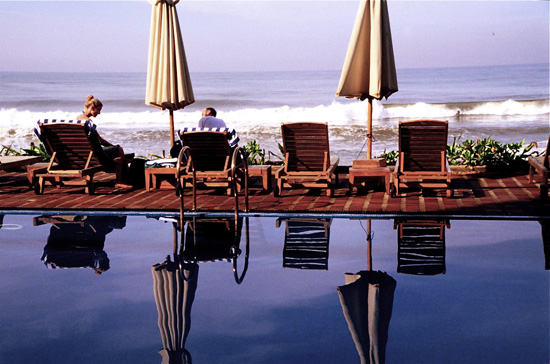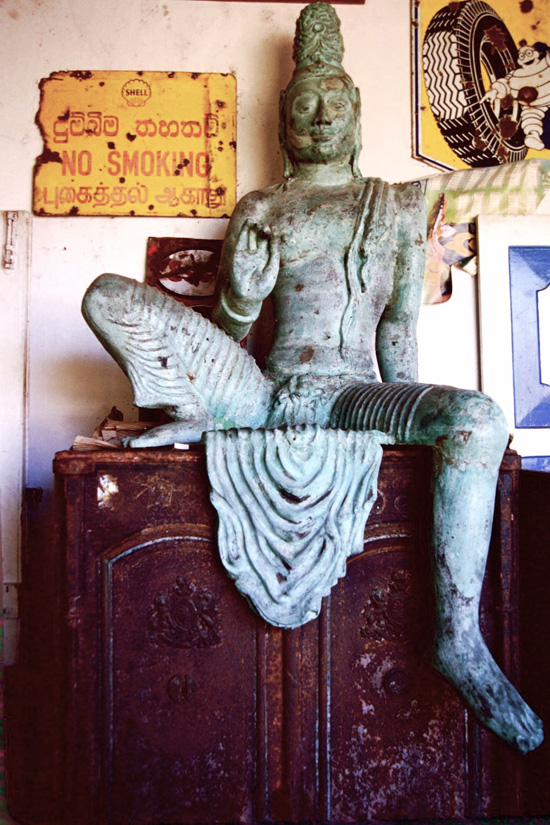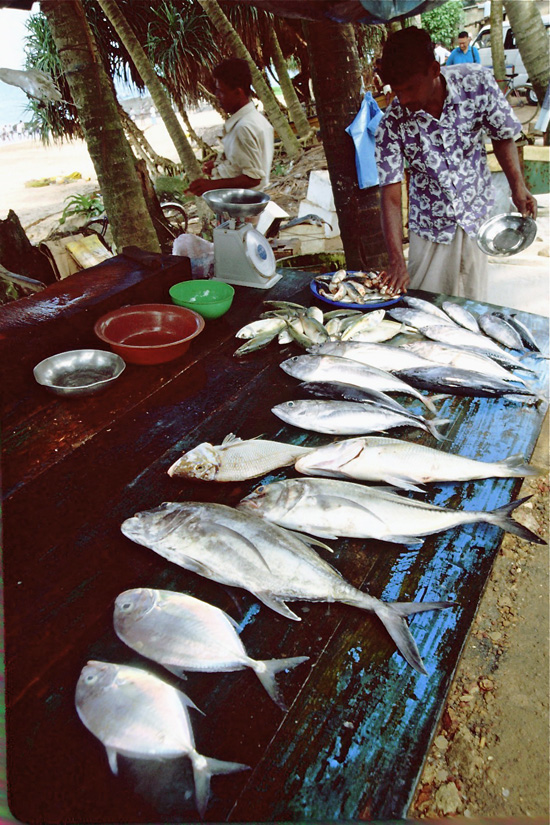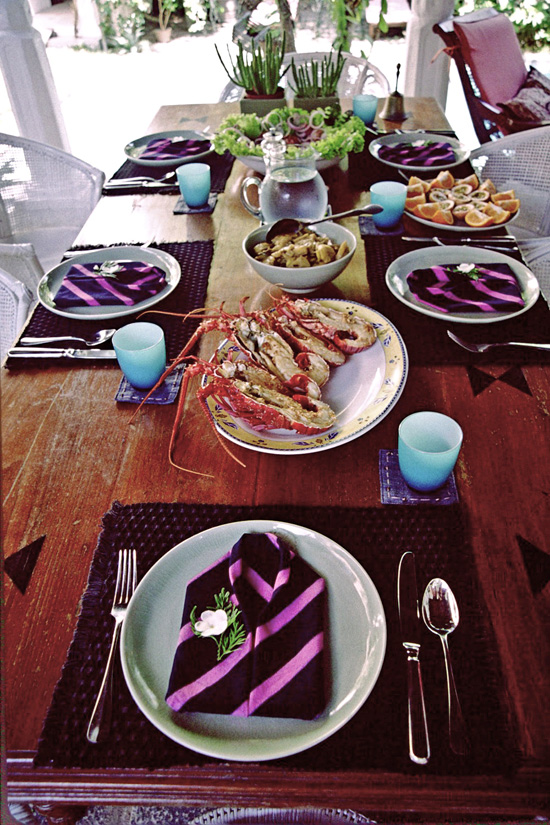December 29, 2009 |
Travel Feature
Sri Lanka: Stalking the Big Blue
Along the road to Galle we see signs of tsunami devastation. Photo: Steven Richter
This story of a monomaniacal adventure in Sri Lanka in January 2006 was written for Gourmet. But when Colombo the capitol, came under attack by the Tamil Tigers in their struggle for independenc, our government posted stern travel warnings. Gourmet decided it was not the moment to encourage travel to Sri Lanka. Now that the insurgents have surrendered,this small island-like country, a lovely, accessible India-light, is seeing tourism again.
January 2006
My passion for jewelry is intense, nearly as consuming as my passion for truffled Nantucket scallops, suckling pig or crusty and creamy macaroni-and-cheese. Between meals as a restaurant critic, I collect vintage fakery and dream of real gems. A few years ago in India I vowed to come home with a string of emeralds. The pitiful slivers of green that fit my budget inspired me to abandon the emerald quest. But now we are headed for a week in sapphire-rich Sri Lanka –the small almond-shaped island at India’s foot. I find myself seized with a sapphire craving. I can actually see it on my finger – big and bold, emerald cut, bluer than Paul Newman's eyes. The Sri Lanka airline magazine on the flight from Delhi is a blur of blue sapphire ads. I promise myself mere money will not stand in my way again. I am going to be good to myelf. I will pry open my cobwebbed wallet and embrace extravagence. Life is short (which is why I sometimes eat dessert first).

Galle Face Hotel in Colombo is a luxury soft landing. Photo: Steven Richter
An Indian friend, Nalin Tomar, an aficionado of Sri Lanka, goes there often. He has booked our trip, saving me tedious hours of winging emails off into the ether. Joining us are Suvir Saran, the cookbook writer and chef-partner of Devi in New York, and Charlie Burd, his partner. It is January, balmy, but not uncomfortably warm. Of course I’m watching my back. The N.Y.Times has reported that the troublesome rebel Tamil Tigers are picking off a few locals now and then, so far only sailors and politicians, but Nalin assures me he has plotted our path--from Colombo to Kandy inland, to the seashore of Galle -- far from the menace. He fills us in on the culture, focusing in ways guidebooks don’t: Prices are lower than India. The people are laid back and friendlier. Everywhere entrepreneurs are building small luxury hotels and spas hoping the tourists will return after the Tsunami.
Suvir lunches at Barefoot Garden Café, hangout for Colombo’s affluent. Photo: Steven Richter
Colombo’s uppercrust and the artists they collect mill around at a photography show opening in the courtyard of Barefoot, a complex of tempting shops, an outdoor restaurant and gallery. Nalin, it seems, knows the Toot Colombo. A prominent local architect is curious about us New Yorkers. What made us come?
Travel lust, we respond.
“And sapphires,” I add. His wife holds out her hand and wiggles a finger – “This is a gray star sapphire,” she says. I admire it dutifully. It is tastefully small. The big blue rectagle I see on my finger will be a deep midnight blue. She offers to see what her dealer has in blue.
Dare I risk a strawberry margarita later that evening at the feverishly popular Gallery Café. Maybe without ice. But the ice is made with filtered water. Oh, let’s just go for it. “Nothing succeeds like excess,” the fusion menu quotes Oscar Wilde. Affluent locals favor pumpkin gnocchi or seared salmon with tuna aioli on pesto risotto here. We are determined to eat Sri Lankan, and are impressed with pan-sauteed prawns alongside tamarind relish, and the black pork curry with rice and eggplant stew. Shanth Fernando, the swaggering entrepreneur owner, is teasingly arrogant tonight but friendly too, spelling out the name of the shop where his wife buys her sapphires for me. I jot the address into my notebook.
Markets, shopping and lunch, in no particular order, are priorities for our fivesome. Suvir and Charlie are stocking up on brilliantly-colored tunics and sarongs from the Barefoot bazaar – so much cheaper than in India – and I’m lost in the book shop. Alas the airline is serious about overweight. Fortunately they don’t weigh people. Our al fresco lunch, fusion again, in Barefoot’s courtyard café, is taking forever to arrive. “You are in the tropics,” Suvir reminds me. I struggle to turn off my New York meter. A cheesey swamp of quiche is the locals’ favorite here. We prefer the sweet-and-sourness of pork curry, voluptuous grilled shrimp, and stolen tastes of Suvir’s vegetable trio.
Costumed dancers assemble in Galle Face lobby to welcome a bridal couple. Photo: Steven Richter
At last my guy and I are free to dash off, innocent and wary, but encouraged by assurances from Sri Lankan friends in New York that Careems in the Hilton Hotel is a safe house for sapphires. When I drop the name of the family that has sent me, Mr. Hassan, small and natty in dress, smiles below his neat moustache, settling in behind the glass vitrine ready to do serious business.
“I am looking for a sapphire,” I tell him. “Unset. Big and very blue.” He signals a minion and a box of folded packets is brought to him from the safe.
“I can’t possibly know if it’s really a sapphire and if it’s been treated to make it bluer?” I confess. “I am counting on you.”
"Ninety-five per cent of sapphires are heated to bring out the color,” he says, assuring me that his are not heated. “You can see now and then tiny flaws, but no inclusions.” He gives me his loup so I can see I’m not exactly sure what in the night sky of a stone. “This is a natural sapphire,” he says. Should I be worried that his nails are bitten. Is that a telltale Rorschach?
"Not blue enough.” I say, rejecting a $36,000 stone, then balancing a $20,000 round on the back of my fingers. “Bigger.” He calls for another stash of folders from the safe. He unwraps a nice little hunk of blue --–just shy of twenty karats --and fits it into a metal ring with prongs that grab it so I can try it on. It’s $40,000. He presents a five karat stone, only $10,000. I am dizzy, I was thinking $3000 or $4000, $5000 tops for something really major. He could put little diamonds around it to make it look larger, he suggests. With his tweezer he arranges small diamonds. He offers to let me have the $40,000 stone for $33,900.
“Maybe my Big Blue jewel isn’t going to be a sapphire,” I say. “Maybe it’s going to be an aquamarine.” I try on a 37 karat aquamarine, just $200 a karat. But it’s definitely sea blue, not even close to a sapphire. He shows me a blue topaz as big as a robin’s egg. No one would ever mistake it for a sapphire.
“What about a pink sapphire or yellow?”
“No. It must be blue. Maybe what I can afford is a big stone with a big flaw,” I suggest. He looks down. Now he knows me better. I have revealed my true self. I want a miracle. He promises to have more sapphires in stock when we return from our excursion to Kandy and Galle.
We catch up with our entourage at one of Shanth Fernando’s smart ultra modern Gallery shops. “Is this big enough for you?” asks Charlie, dropping a heavy silver ring in my palm. It’s kind of clutzy but compelling, a mammoth cabochon aquamarine, pale blue, very eccentric English duchess… just $110. I must have it. They take credit cards so I’m even piling up a few miles. I feel stronger, more decisive, having bought something. I am growing serious, working up to going for broke on my sapphire.

We stop at Waruma’s shop in Kandy for lunch and treasures. Photo: Steven Richter
Kandy is theoretically only two and a half hours away but traffic snarls the two-way highway and our rented van takes forever. Nalin phones his favorite antiques dealer in Kandy, Waruna Jayasinghe, from the car. Waruna invites us to join a few locals for lunch… a funeral lunch. A cheerful funeral lunch. Local tradition requires the bereaved family to share food with friends for 11 days after a death. Waruna, his face wreathed in a wild beard, fussed at by three generations of the clan females in saris, seems jolly enough. They urge us to share their spicy stew of meaty breadfruit, curried potato and eggplant, fresh fruit and chapati bread set out on a colorful woven cloth as if they’d been expecting us.. Afterward the five of us scramble through Waruna’s three dusty floors of stone, wood and brass collectibles looking for treasure. Nalin buys a vintage fabric. I scan the jewelry under glass at the front of the shop, rare and real, not so rare, not so real. A delicate gold filigree ring with a sapphire is very cheap but also tiny. Perfect for Eloise at the Plaza. Waruna suggests a jeweler just down the street is more likely to have the sapphire I am seeking.
Ceygems International has its own gemological museum upstairs: I am like a nine-year-old girl in a Barbie museum, devouring the diorama of every imaginable mineral and precious stone. Quickly our museum guide morphs into gem-hustler, leading us downstairs, surprise, right into the shop. It takes only minutes to conclude that I am not going to find big blue of my fantasies among the itsy blues here.

At the famous Temple in Kandy, a priest comes with the key. Photo: Steven Richter
The roads north of the city are so clogged, it takes forty minute for the advertised ten minute ride to Kandy House, a luxurious and handsome small inn of indigenous stone floors and massive Dutch antiques, armoires and buffets, where a waiter in orange sarong waits to welcome us with luscious passion fruit mocktails. I ignore the nagging inclination to run out and dutifully sight-see in favor of tea, a shower and a nap. Shopping and eating, I find, are more exhausting than mountain climbing. As for Kandy House’s resident chef, a self-admitted amateur, his omelet or perfect poached eggs, bacon, fruit and yogurt, three kinds of toast, and good strong coffee at breakfast on the verandah overlooking the garden, is infinitely more satisfying than a rather amateurish lunch that takes too long and makes me sleepy.
Ena deSilva is a legend who wears three hats and sponsors local crafts. Photo: Steven Richter
Nalin has arranged for a private audience next day with the unofficial dowager empress of Kandy, Ena de Silva, at the Heritage Center she has created near her home so that villagers can learn nearly-forgotten crafts. A spry 84-year-old wearing three hats, one on top of another, with her silver-tipped cane, “just for balance,” she leaps like a mountain goat over stony paths to the batik atelier and through her charmingly eccentric garden with its stone Queen’s throne overlooking the valley. As tourists just passing through, we would be lunching at Aluwihare’s Kitchen below. Instead her staff is setting up a staggering buffet in the grand dame’s living quarters, a rainbow bazaar of treasured clutter.
“The King gets 35 curries. We give 24,” she observes. “We’re eating pretty much what we serve at the restaurant.” The table is a riot of color, chairs draped with blazingly printed shawls, below giant waxed flowers her students make in primary colors. Ena is a fount of naughty gossip, almost as delicious as the splendid Kandyan feast: the two dozen different curries: cashew nut, fragrant chicken, spiced ladyfingers (okra), melting eggplant, sweet potato, all sorts of chutney’s and pickles, turnovers and meat pies.
Once I’ve tasted everything, I suddenly remember the hunt for Big Blue and am shameless in my quest. “I don’t suppose you know any elderly windows who would like to sell their sapphires,” I ask.
Ena wiggles gem-free fingers. “I gave away all my jewels to my daughter in Los Angeles. Now I don’t have to worry about being robbed.”

Fisherman put out a meager catch alongside the road to Galle. Photo: Steven Richter
On our way south, we stop at Lunuganga, a well-known plantation house and garden paradise carved out of a tropical jungle over several decades by the country’s legendary architect, the late Geoffrey Bawa. Only recently open to guests, each room is different and some have an upscale tree-house feel. A friendly American journalist, parked here overnight with her mother, offers travel tips, including a favorite jeweler. “Mr. Ibrahim in Galle,” she advises, writing out the address. “I trust him totally.” Lunch, reserved ahead, is set out on moss green linen: spritely red pepper and caper tossed spaghetti, tuna seared medium rare --tender and savory –and a cheese cake tart with segments of lime taming its sweetness. All very elegant and delicious.
Driving south again along the coast, we see constant images of tsunami destruction and rebirth: the rafters of a house and nothing more, palms lying on the sand, just built white-washed cottages next to flattened shacks, freshly planted tree sprigs belted to stanchions against the wind. Survival is a work in progress.

“What would we like for lunch?” asks the chef at Orchard House. Photo: Steven Richter
Below the town of Galle itself is a 17th Century Fort enclave where stone walls withstood the devastating waves. Its narrow streets are studded with smart boutiques, tee-shirt emporiums, stalls of tourist tchotkes, and small hotels like the handsomely restored Orchard House that Nalin has rented for three nights. Some of us are poets. Some of us are earthbound. Couples work best when one half can be assertive and practical while the other sniffs the flowers, or rffles through dusty books. I push our bags into one of the four air-conditioned rooms decked out with early 19th Century Sri Lankan furniture by our absentee Australian landlords. To reach the high queen size four poster, I have to step up on a mahogany stool.
Next morning, we linger over a four course al fresco breakfast in the gazebo beside the pool: fresh squeezed orange juice and an astonishing platter of tropical fruit, tiny bananas with a big banana pow, ripe mango, passion fruit and mangoustines. What a relief to be liberated from the splendid excess of a five-star hotel buffet where I will always eat more than I meant to. We wander the streets of the Fort, in and out of shops, surprising each other with gifts, a burgundy and gold scarf for me from Suvir, chocolates for the men from us. By the time we reach the boutique of the trusted Mr. Ibrahim, Suvir and Charlie have a raging case of gem fever too. Alas, Ibrahim’s sapphires are not the big blue I had in mind. But Suvir fancies a modest star sapphire and a bright aquamarine to match Charlie’s blue eyes. I find myself taken by a fiery garnet. “Would you like that to be my Christmas gift to you?” my guy asks.

Mr. Ibrahim in Gall tries to tempt me with a stunning aquamarine. Photo: Steven Richter
"Well, yes. I love it. If the price is right,” I begin.
But Suvir steps in, a relentless bargainer, alternately cajoling and then, jabbing with a killing barb. I have to walk away to keep myself from trying to defend Mr. Ibrihim. But then the deal is sealed. We leave with all three stones. What a high it is to think this blazing emerald-cut garnet might actually be a bargain Now that we’ve spent $500, I feel more ready than ever to close on a significant sapphire.
Back at the Colombo Hilton Careems feels a bit like home. The familiar face of Mr. Hassen is instantly reassuring. He sets a 17.62 karet stone into the try-on prongs. It has a few inclusions, but no flaw, he says. $11,717. There is a deep blue emerald cut stone. $33.915. Just my color. Not my price. A 13.60 karet stone has a flaw. And its only $6180. He lets me look with the loup. “It’s called a love eye,” he says.
The stone really sparkles and I like the medium cornflower color – brighter than the greyed blue of bigger stones that are out of my price range anyway. It does look a little small on my finger.
“It has very good luster. A lot of plus points,” Hassen assures me. “The shape is very pretty. You won’t find anything better for the price anywhere.” I can have it for $5850.
I want it for $5000, I say. “I only have $5000 to spend.” We are both silent for what feels like an hour. Then with a phone call as if he has to get permission, and with a grimace of pain, he reduces it again to $5350. Add on the cost of an 18 karet white gold setting and four tiny diamonds in each corner, $5680, no charge for mailing.
“We’ll think about it overnight,” I say imagining he won’t want to let us out the door.
We’re out. “He knows I want that stone,” I mutter as we climb into a little bicycle-like put-put taxi. (If you’re abut to buy a $5000 sapphire, you need to save $2 on your taxi is how I live my life).
We unleash Suvir on Hassen next day. Not even 45 minutes of grilling by Suvir moves him. My heart is pounding. This is a very aerobic sport. Steven can’t stand the tension.
“Buy it or don’t buy it,” he says. “Buy it. You deserve it.”
Back in Colombo at Careems, Mr. Hassan measures my sapphire. Photo: Steven Richter
The deal is done. We’ve paid but we’re leaving with nothing but an official-looking certificate. My pulse is racing. I get up dizzy and hot. The jeweler will send a drawing of the proposed setting by email for my approval. What an amazing world. I am buying a sapphire in Sri Lanka and designing the setting on the internet.
“Do we have time for ice cream before we leave for the airport.”
***
Second Guessing My Sapphire
I am struggling with a writing deadline when a giant cardboard carton box arrives in my office some weeks later. Manufacturers send me potato chip or popcorn samples in boxes like that. It sits for two days before I take time to open it. Inside the carton is a large tin box and inside that a small cardboard box hiding a tiny blue velvet box embedded in tissue. This clever camouflage of wrapping is designed to make jewel thieves ignore my package. My not so big, not so blue Big Blue Sapphire.
I emailed Hassen that the ring had arrived safely. He replies: “Yes indeed you are amongst few women in the world who owns a sapphire with a such a big size. God bless.”
***
Of course I must have it appraised. Am I a New Yorker or what? Cartier’s president emeritus Ralph Destino arranges for me to bring my ring for analysis to the Gemological Association of America on Fifth Avenue. He meets me there. It’s a little bit like Fort Knox with armed guards to escort you and small pass-through windows where you surrender your gem to a clerk who makes a fax of it. They don’t appraise, they analyze. Two experts will check out my bauble Destino explains. That’s how they do it. A double check. The chief of colored stones herself takes me backstage to the colored gem room and shows me the machinery. And both gemologists agree. The good news: It’s a natural sapphire. The bad news: it has been heated to enhance the stone creating an inclusion. At first I’m angry. But then I realize I did tell Hassen that I wanted to see bigger stones with bigger flaws. In his careful, non-alarmist way, even wily way, he never actually mentioned the stone had been treated with heat but then again, he never said it wasn’t. What he might have said in the blurry moment of my feverish wanting was that this was not his usual gem but a stone obtained from a dealer.
It took ten days for free lance appraisers to weigh the issues of my stone and study the immediate retail market for a 13 and a half karat sapphire. It would cost me $11,500 to replace my stone, they said. Not $20,000 or $25,000 as I’d day-dreamed, remembering Hassen’s perspiration at the end of what felt like a searing negotiation. As if he was giving away his children’s heritage and education. Crocodile tears.
So I’d come home with an $11.500 gem for my $5000. At least I hadn’t spent every waking moment of the week stalking the Big Blue. I’d taken time to skim the cream off the coconut milk of Sri Lanka’s richness in just six days. I’d met the sophisticated and ambitious upper class of Colombo and passionate characters along our route. I’d seen the aura of optimism in rebuilding from the catastrophe and many new boutique hotels and smart restaurants in the works with an uprising so far away that barely made shadows. I would sell the story and maybe next time, I’d go to Brazil and buy my dream emerald.
***